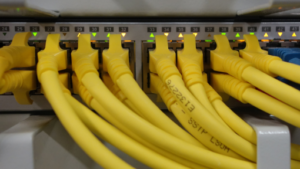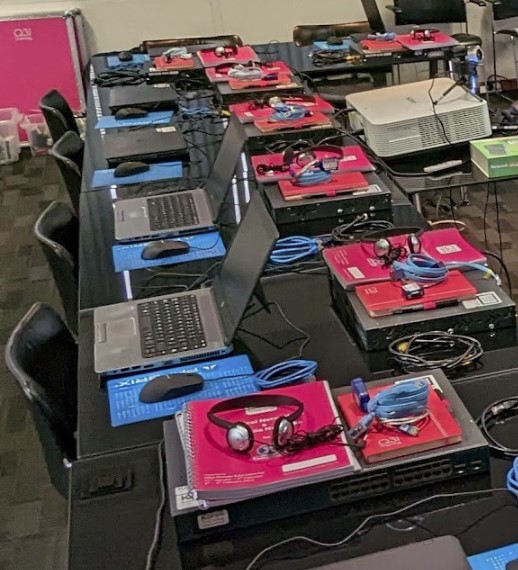Practical Introduction to IP Networking
4 days

Overview
Starting from the basics and assuming minimal prior experience, these sessions will introduce the concepts of IP networking considered appropriate to engineering roles working with broadcast systems.
Attendees of this session will have much greater confidence in their understanding and ability to configure IP networks and work with systems which sit upon them.

Trainees will have access to a PC and network switch and in addition to having concepts explained will follow-along with configuring network settings and routing.
Concepts of layer models and IP, TCP, UDP will be introduced and trainees will gain experience of VLANs and routing configuration.
Concepts of UDP multicast and A/V streaming with RTP will be covered, with trainees exchanging flows with others across a routed network which they have helped configure. This is a key topic for networking in a broadcast/media environment which is rarely covered by other introductory courses – RTP is the basis of media protocols such as SMPTE 2110.
Reference will be made to broadcast concepts and architectures, but detail of specific IP Media standards and formats will not be covered. If this is required, the content of our TR1001 IP Media Networks course can be covered in an additional 2 days (including all practicals), ideally run back-to-back with this course with the same attendees. This practical networking will have covered the basic networking concepts and UDP/RTP multicasting that is also part of that course so the additional 2 days would not be the same as the ‘abridged 2-day’ version.
Please contact us for a more detailed document outlining the syllabus for this course. Topics may be tailored to best suit attendee requirements.
Modules & Practicals
MODULE 1 – Introduction to IP Networking
- What is IP? Comparison with broadcast signals
- Fundamentals of packet switched networks & layer Models
MODULE 1 Practicals:
- Basic switch configuration – LAN network setup, IP addressing
- Packet analysis using Wireshark
MODULE 2 – Layer 1 and 2 Ethernet
- Overview of Ethernet – standards and speeds. Ethernet frames, Addressing
- Physical connection types (Copper, Fibre, SFPs)
MODULE 2 Practicals:
- Configure VLANs and VLAN trunks
- Layer 2 redundancy: Spanning tree protocol, link aggregation. LLDP
- STP and broadcast storms
MODULE 3 – Layer 3 IP
- IP versions 4 and 6 addressing
- What’s in the IP header – how does it work
- DHCP & APRP
MODULE 3 Practicals:
- DHCP. ARP operation
- ICMP Tools (even though this is layer 4!) – Ping, Traceroute, Pathping
- Configure switches and routers to make static routed network
MODULE 4 – Layer 4 TCP and UDP
- What are they? Differences and uses
- Port numbers & Sockets
- UDP header & use for streaming
- TCP header, TCP operation
MODULE 4 Practicals:
- Identify TCP and UDP traffic in Wireshark. Filter to show a TCP session and look at some TCP headers
MODULE 5 – Application-Level Protocols
- Protocols and the uses they are put to in broadcast systems
- FTP, HTTP, WebSocket protocol
- Overview of DNS and mDNS
MODULE 5 Practicals:
- HTTP/HTTPS traffic analysis with Wireshark – decoding encrypted traffic (TLS, HTTP2, HTTP3)
- DNS operation
MODULE 6 – Streaming and Multicast
- Packet switched networks and real-time signals – contention, latency, jitter, QoS
- Realtime RTP/UDP vs HTTP streaming
- RTP use in broadcast standards such as SMPTE ST 2110 and AES67
- Unicast vs multicast. Multicast IP addressing
- IGMP – versions 2 and 3, IGMP snooping, Multicast routing (PIM)
MODULE 6 Practicals:
- Unicast and multicast streaming using VLC with and without IGMP snooping
- Multicast routing demonstration
MODULE 7 – Network Architecture
- Monolithic single switch vs hierarchical architecture (spine & leaf / n tier)
- Campus and data centre networks
- Layers: core, aggregation/distribution, access. Use of MC-LAG vs ECMP
- Relationship between VLANS, subnets, VRFs, firewalls and firewall zones. Layer 2 vs Layer 3 designs
Course Trainers
Pricing

Mike Dhonau (Lead)

Ed Calverley
Pricing (2026) for this 4-day course is £9,650 plus expenses. An all-inclusive fixed price quote will be provided on request. This is a fixed fee regardless of the number of attendees, there is a strict maximum of 8 attendees due to the hardware used and to allow for adequate support in practical sessions. Inclusive pricing covers all travel, subsistence, printing and other expenses plus access to PDF versions and access to view session recordings (for revision use).
One of the above trainers will run this course but both regularly update the content to make each session as effective and up to date as possible.
View Our Other Courses
Broadcast Video & Technology for Developers
1 or 2 day course tailored to file and/or live workflows.
What makes Broadcast Video special? This short course is aimed at software developers who are working with solutions for use in broadcast. What are the key technology aspects everyone should know. The basics of Broadcast Video and Audio will be introduced, explaining important topics like interlace and colour sub-sampling (what is 4:2:0!?).
TR-1001 IP Media Networks
This session covers everything you need to know about IP-based networking for Media Production. It covers all the essential network protocols and standards for uncompressed video over IP (SMPTE ST 2022-6 / ST 2110) as well as looking at how to make such systems work through the use of PTP and NMOS specifications.
Broadcast Engineering Essentials
3-5 day course covering the fundamentals of broadcast technology that every engineer and technician should know. Attendees of this course will be more confident and able to tackle any new technology challenges they may face is their broadcast systems evolve.
AutoCAD LT for Broadcast Engineers
2-day practical course (or 1-day abridged) covering all the tools and techniques for using AutoCAD LT in a broadcast setting. Focussing primarily on modifying existing broadcast system schematics (i.e. video and audio system diagrams), but also touching on rack layouts & more.
Broadcast Industry & Technology Intro
This 1 or 2 day course has been put together to provide a cost-effective way to address the often-overlooked basics of the broadcast industry and its technology whilst also having a positive impact on staff morale by encouraging back-office/admin staff to be included in the initial session(s).
APIs and Web Technologies for Broadcast & Media
This highly practical, hands-on 2-day course introduces the technologies used to support web interfaces, the servers behind them, API (Application Programming Interface) integrations with other systems and data sources, and the security methods used to keep everything safe from attack.
No coding experience is necessary - this course is aimed at staff needing an awareness when working with software teams/vendors
Practical Introduction to IP Networking
This hands-on 4-day course gives attendees greater confidence in understanding IP networks in a broadcast setting. Starting from the basics, trainees will learn everything they need to know (layer models, VLANs and Routing, TCP/IP, UDP Multicasting, RTP Streaming and more!)
